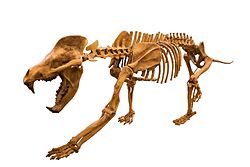Amphicyon
|
Amphicyon Temporal range: Aquitanian–Pleistocene Early Miocene to Early |
|
|---|---|
 |
|
| A. ingens, American Museum of Natural History | |
| Scientific classification | |
| Kingdom: | Animalia |
| Phylum: | Chordata |
| Class: | Mammalia |
| Order: | Carnivora |
| Suborder: | Caniformia |
| Family: | †Amphicyonidae |
| Genus: |
†Amphicyon Lartet, 1836 |
| Type species | |
|
†Amphicyon major Blainville, 1841 |
|
| Species | |
|
|
Amphicyon ("ambiguous dog") is an extinct genus of large carnivorous bone-crushing mammals, popularly known as bear-dogs, of the family Amphicyonidae, subfamily Amphicyoninae, from the Aquitanian Epoch until the early . They ranged over North America, Europe, Asia, and Africa from 16.9—2.6 Ma ago, existing approximately 14.3 million years.
Amphicyon was the typical bear-dog amphicyonid with morphology similar to both bears and dogs. With its robust build and maximum length of 2.5 m (8 ft), the largest species looked more like a bear than a dog. It had a large heavy tail, thick neck, robust limbs and teeth like a wolf. It was probably an omnivore with a lifestyle comparable to that of the brown bear.
A single specimen was examined by Legendre and Roth and estimated to have a body mass of 84.2 kg (190 lb), roughly half that of Ischyrocyon and roughly the same as Epicyon which shared its time period and habitat. A. ingens was much bigger: Sorkin (2008) estimated the largest known specimen (AM 68108) to weigh 600 kg, making it one of the largest known amphicyonids.
The earliest occurrences of Amphicyon in North America are from the early to mid-Miocene, found in the Runningwater Formation in Sioux County, Nebraska, and from the lower part of the Troublesome Formation, Colorado (A. galushai, A. frendens, and A. ingens). Although other large amphicyonids from the Miocene of North America have been placed in Amphicyon, many of these carnivores are now placed in other amphicyonid genera. The Amphicyon lineage in the New World is restricted to the above three species (18.8–14.2 Ma). Particularly rich samples of the large North American species of Amphicyon have been found in the Sheep Creek Formation (A. frendens) and Olcott Formation (A. ingens) of central Sioux County, northwest Nebraska.Amphicyon has also been found in France and Spain in Europe. Amphicyon's youngest range is on the Indian subcontinent, where it disappeared only in the early .
...
Wikipedia
